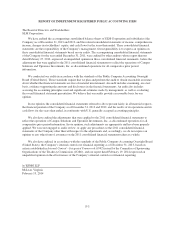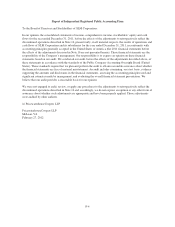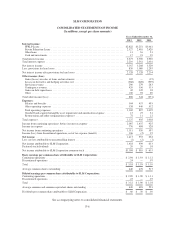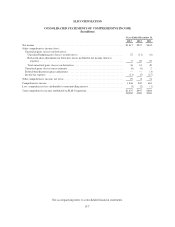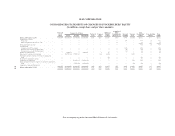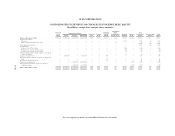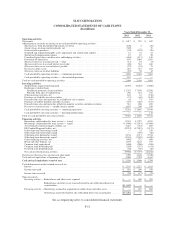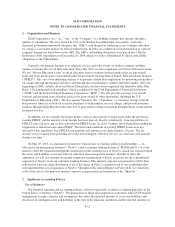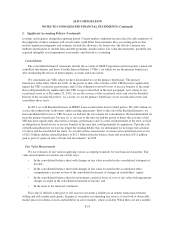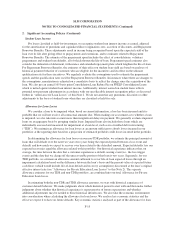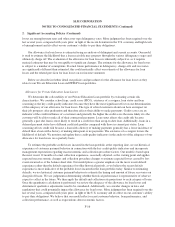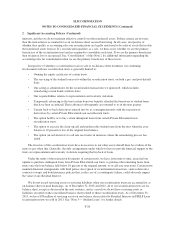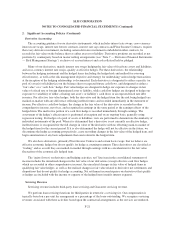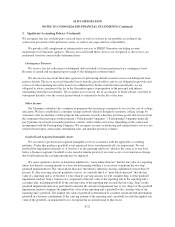Sallie Mae 2013 Annual Report Download - page 151
Download and view the complete annual report
Please find page 151 of the 2013 Sallie Mae annual report below. You can navigate through the pages in the report by either clicking on the pages listed below, or by using the keyword search tool below to find specific information within the annual report.SLM CORPORATION
NOTES TO CONSOLIDATED FINANCIAL STATEMENTS (Continued)
2. Significant Accounting Policies (Continued)
revenues and expenses during the reporting period. Current market conditions increase the risk and complexity of
the judgments in these estimates and actual results could differ from estimates. Key accounting policies that
include significant judgments and estimates include the allowance for loan losses, the effective interest rate
method (amortization of student loan and debt premiums and discounts), fair value measurements, goodwill and
acquired intangible asset impairment assessments, and derivative accounting.
Consolidation
The consolidated financial statements include the accounts of SLM Corporation and its majority-owned and
controlled subsidiaries and those Variable Interest Entities (“VIEs”) for which we are the primary beneficiary,
after eliminating the effects of intercompany accounts and transactions.
We consolidate any VIEs where we have determined we are the primary beneficiary. The primary
beneficiary is the entity which has both: (1) the power to direct the activities of the VIE that most significantly
impact the VIE’s economic performance and (2) the obligation to absorb losses or receive benefits of the entity
that could potentially be significant to the VIE, except as described in the next paragraph. As it relates to our
securitized assets as of December 31, 2013, we are the servicer of the securitized assets and own the Residual
Interest of the securitization trusts. As a result, we are the primary beneficiary of our securitization trusts and
consolidate those trusts.
In 2013, we sold Residual Interests in FFELP Loan securitization trusts to third parties. We will continue to
service the student loans in the trusts under existing agreements. Prior to the sale of the Residual Interests, we
had consolidated the trusts as VIEs because we had met the two criteria for consolidation. We had determined we
were the primary beneficiary because (1) as servicer to the trust we had the power to direct the activities of the
VIE that most significantly affected its economic performance and (2) as the residual holder of the trust, we had
an obligation to absorb losses or receive benefits of the trust that could potentially be significant. Upon the sale
of the Residual Interests we were no longer the residual holder, thus we determined we no longer met criterion
(2) above and deconsolidated the trusts. As a result of these transactions, we removed securitization trust assets
of $12.5 billion and the related liabilities of $12.1 billion from the balance sheet and recorded a $312 million
gain as part of “gains on sales of loans and investments” in 2013.
Fair Value Measurement
We use estimates of fair value in applying various accounting standards for our financial statements. Fair
value measurements are used in one of four ways:
• In the consolidated balance sheet with changes in fair value recorded in the consolidated statement of
income;
• In the consolidated balance sheet with changes in fair value recorded in the accumulated other
comprehensive income section of the consolidated statement of changes in stockholders’ equity;
• In the consolidated balance sheet for instruments carried at lower of cost or fair value with impairment
charges recorded in the consolidated statement of income; and
• In the notes to the financial statements.
Fair value is defined as the price to sell an asset or transfer a liability in an orderly transaction between
willing and able market participants. In general, our policy in estimating fair value is to first look at observable
market prices for identical assets and liabilities in active markets, where available. When these are not available,
F-13


